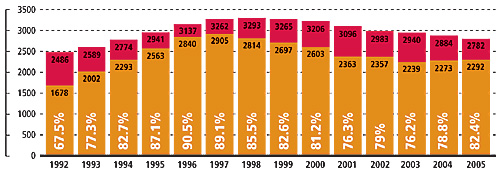
Fam Pract Manag. 2005;12(4):37
Match Day 2005: Family medicine gains positions, loses U.S. seniors
Family medicine residency programs gained 19 positions this year for a total of 2,292 positions filled, according to preliminary data from the National Resident Matching Program (NRMP), released March 17. Among all primary care programs, only family medicine experienced an increase in filled positions this year. The fill rate for family medicine residency positions increased to 82.4 percent, compared to 78.8 percent in 2004, as fewer positions were offered in 2005.
However, 66 fewer positions were filled with U.S. seniors, which has the AAFP concerned, as international students often return to their country of origin following training and those who stay in the United States are less likely to practice in rural, underserved areas. Since 1998, the number of U.S. seniors selecting a family medicine residency program has declined by 1,047.
How other specialties fared
Over the past several years, medical subspecialties have generally fared better than primary care in the NRMP. For example, internal medicine-preliminary gained 118 positions, with 55 more positions filled with U.S. seniors, for a total of 1,803 positions. (Students choose an internal medicine-preliminary year to prepare for further training in a subspecialty.) Anesthesiology gained 25 positions with four more positions filled by U.S. seniors, for a total of 439 positions. Obstetrics/gynecology residencies gained 17 positions, with 29 more U.S. seniors, for total of 1,083 positions.
Why the decline for primary care
For the past seven years, U.S. medical school graduates have gravitated toward specialties that offer more flexible lifestyles and potentially greater financial rewards, according to AAFP analysis. They are also choosing practice environments with less productivity pressure and more lucrative third party-payer reimbursement.
The AAFP believes that the culture within many medical schools actively discourages careers in family medicine. Fewer students are being mentored by family medicine faculty, who report an increase in direct patient care activities, which leaves less time for teaching and advising.
Family medicine positions offered and filled, 1992 to 2005

Study explores link between physician supply and mortality rates
A recent study of death rates U.S. counties concluded that the in greater the supply of primary care providers, the lower the mortality rates.
That finding, which was statistically significant even after sociodemographic variables such as income, education and employment were factored in, mirrors previous studies of state-level data.
The study, published in the March 15 online edition of Health Affairs, also examined the county-level relationship between specialists and mortality rates. It found that the higher the specialist-to-population ratio, the higher the mortality rates. However, that relationship did not hold up when sociodemographic variables were considered.
The article also examined health outcomes in other Western industrialized countries and found that the specialist-to-population ratio has little significance.
“It appears that it is the relative roles of primary care physicians and specialists rather than their number that makes the difference in health outcomes,” the article’s authors wrote.
Robert Phillips, director of the Robert Graham Center, believes the study by Barbara Starfield, a professor at the Johns Hopkins School of Public Health, and three co-authors should help shape discussions on the future of the U.S. physician workforce.
“Policy-makers should pay attention to Starfield and colleagues’ troubling finding that having more specialists is not a good thing, and that primary care is,” Phillips and his co-authors wrote in a separate online article for Health Affairs.
Patients want e-mail access to physicians but don’t want to pay
Americans continue to show interest in online communication with their physicians. According to a February 2005 survey conducted by Harris Interactive, 80 percent of respondents said they would like to use e-mail to ask their physician a question when an office visit is unnecessary. This was a 3-percent increase from 2002. Respondents also expressed the desire to schedule appointments (69 percent), renew prescriptions (67 percent) and receive test results (69 percent) online.
However, when respondents were asked whether they would be willing to pay for online communication with their physician, only 36 percent of the 2,638 respondents said yes, compared with 37 percent in 2002. This will likely delay the widespread use of online patient-physician communication, as physicians are reluctant to take on more uncompensated work.
Small practices report success with EHRs
Small physician practices can successfully implement an electronic health record (EHR) system with minimal start-up and maintenance costs, according to a March 8 report on the AAFP’s EHR Pilot Project. The key to cost-effectiveness in the pilot practices was using application service providers (ASPs), which are companies that rent software to users and deliver it online. ASP systems require medical practices to purchase fewer hardware components, and they are easier to maintain and upgrade than traditional EHR systems.
High costs have been a barrier to EHR adoption among small practices. A recent study by the AAFP’s Center for Health Information Technology (CHIT) shows that the average three-year cost for a traditional (non-ASP) integrated EHR and practice management system is $68,371 for a three-physician practice, or $7,600 per physician per year. Though still high, these costs are coming down, according to the CHIT study.
The pilot project showed that small practices with tight budgets could reduce the costs and challenges of training, implementation and support by employing a combination of Web conferences, e-mail discussion lists and telephone meetings instead of bringing expensive vendors on site.
Ken Bertka, MD, a family physician from West Toledo, Ohio, who participated in the pilot project, said his ASP model worked well. “Despite a direct lightning hit and a major flood in our office, our EHR was down for less than two hours total in a six-month period,” Bertka said. “That level of reliability exceeds what most large health systems experience.”
The EHR Pilot Project involved six small family medicine practices and was conducted over a six-month period by CHIT, with the goal of identifying barriers and keys to successful EHR implementation, particularly within small and solo practices. The full report is online at http://www.centerforhit.org/x254.xml.